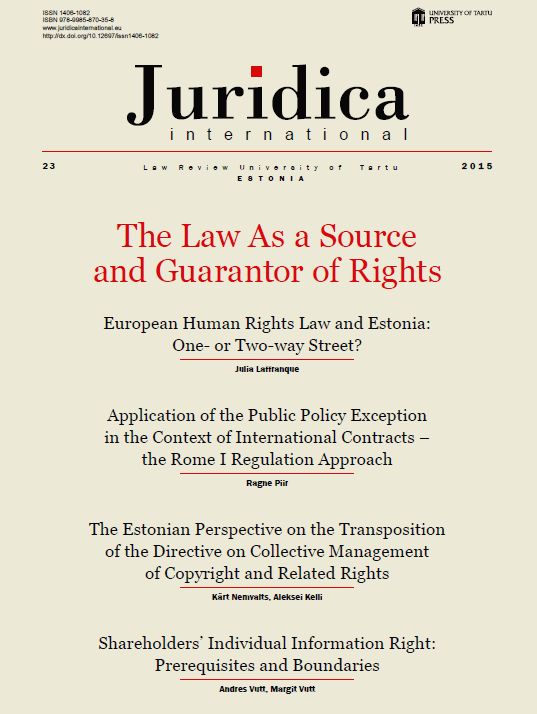European Human Rights Law and Estonia: One- or Two-way Street?
DOI:
https://doi.org/10.12697/JI.2015.23.01Keywords:
European Convention on Human Rights and the Estonian legal order, European Court of Human Rights, democracy and the rule of law, reopening and implementation of judgementsAbstract
The article discusses the impact of the European Convention on Human Rights (‘the Convention’) and the case law of the European Court of Human Rights on Estonian law. It gives historical background on the ratification of the Convention and its protocols by Estonia and describes the status of the Convention in the Estonian legal order. It then shows in more detail the impact of the case law of the Strasbourg Court on Estonia’s legislature, executive power, and judiciary and examines the case law pertaining in particular to the historical past, deprivation of liberty, prison conditions, fair trial and length of proceedings, retroactivity, and lack of foreseeability of criminal law, along with the case law on pluralism and civil rights, especially freedom of expression. In addition, the article focuses on the important issue of reopening of a case on national level once the European Court of Human Rights has found a violation and looks at the implementation of judgements of that court by Estonia in general. Additional remarks are made on the Supreme Court of Estonia’s application of the Convention and the case law of the European Court of Human Rights. Finally, the impact of the case law of the Strasbourg Court in relation to Estonia on the general development of precedents with that court is discussed.
In conclusion, in relation to the case law of the European Court of Human Rights, it is important to understand that the Court finding a violation of the Convention in respect of Estonia is not so much a condemnation, ‘against’ the country, as a learning opportunity, in a sense, for Estonia’s democracy, rule of law, and human rights protection system. Furthermore, there could well be other difficulties in Estonia that the Court has for various reasons had no opportunity to address. This can be seen in areas wherein the Court has found a violation by another state but wherein a similar problem still exists in Estonia – e.g., in relation to prisoners’ voting rights. It is important to consider a more global picture of the human rights situation. It is unfortunate that in Estonia, especially in the media and for the wider public, little attention is paid still to the case law of the Court with respect to other states.
In general, European law has been well accepted in Estonia, especially the Convention and the case law of the Court. Working from the Estonian examples, one can confirm that the legislature; the executive power, even more so; and, above all, the judiciary of Estonia have recognised well that the Convention is an inseparable part of Estonia’s legal and democratic culture. Estonian courts need to feel that they also are human rights courts, especially in dealing with the facts and Estonian law, domains wherein the Court cannot and should not act as a fourth or first instance. At the same time, the Court should be able to speak not only to the Estonian courts as counterparts but also to the Estonian people. They as well need to understand European human rights law. All in all, Estonia is quite lucky: it does not have particularly worrying human rights problems; not many violations of the Convention are found in respect of Estonia by the Court.
Estonian cases have been dealing with more or less the same issues every ordinary democratic country faces, even to a certain extent with problems of a modern, well-advanced society, such as freedom of expression and privacy rights on the Internet. Also the Court has been lucky to have Estonia as an exemplar: a country wherein the Convention system and the Court’s case law have been to a large extent respected and well complied with. But this mutual ‘happiness’, this quite nice two-way street, should not be taken for granted. The Court’s case law is a moving target. It is hoped that all future developments related to the Court will contribute to improvement of the protection of human rights, democracy, and the rule of law all over Europe. Neither Estonia nor any other European country can apply the generally recognised principles by choice ‘in its own way’. Estonia’s trump in Europe and beyond could be to serve as a model in the protection of human rights. In consideration of its experience, geopolitical location, and size, alongside its investments in education and the historically rooted importance of nurturing intellectual and cultural values, Estonia could be in a very good position to achieve this ambitious goal.


